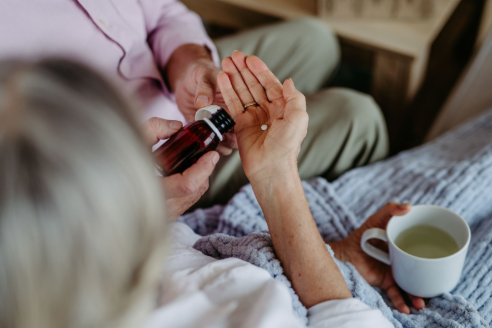
True story. Many patients who come to me for joint pain and rheumatoid arthritis tell me this story.
The pain in their joints prevents them from doing the things they dream of, such as gardening with grandchildren, exploring new hobbies, traveling, or just being active. Treatments offered are often limited in how long they will work or if the disease will progress. They want more hope. They don’t want their pain to dictate what they can and can’t do.
Googling may give them a glimpse into some natural herbs that may help lessen the discomfort. However, they are not sure how much to believe or how much effort and hope to invest in their trial of these ideas. Since this is not their expertise and they know few who have tried this route, it is so confusing, and sometimes even embarrassing to discuss these ideas with friends and family.
In the quest for better options, they find a qualified professional who has done this before and can trial and error botanical options for their specific pain needs. Naturopathic doctors have the added benefit of know-how for what drug and herb interactions are important to point out, as well as discussing lab options for possible causes and long-term treatment. Many patients are able to get back to gardening with grandchildren, traveling, aging gracefully, and doing the things they want without pain.
Holistic Strategies and Natural Remedies for Rheumatoid Arthritis Relief
Drugs are often not enough for the pain that comes with rheumatoid arthritis. They also come with unpleasant side effects that make patients feel they are not worth the risk of using. Natural herbs have fewer side effects, fewer complications, and the demand to use them as natural painkillers has been growing (Yousofvand). However, education around the use of herbs in standard medical care is very limited, and the interactions are even less known by most doctors.
Rheumatoid Arthritis (RA) patients frequently seek additional sources for relief. They often ask their doctor about diet. They are willing to make changes, however they lack direction. Fortunately, naturopathic doctors are well trained in botanicals, the immune activity of rheumatoid arthritis, and the interactions between drugs, food, and botanicals, as well as the mechanisms of action. All this is included in their board exams. Read on and find some hope with herbal remedies for rheumatoid arthritis.
Herbal Remedies for Rheumatoid Arthritis and Chronic Pain
Most all these herbs that we will discuss here are anti-inflammatory, often modulating the immune system for good things as well as helping with pain. By addressing inflammation, we are often addressing nutrient deficiencies and root causes of the disease process as well!
Boswellia can greatly improve stiffness. It’s great for a workout or chronic pain and helps with belly discomfort as well.
Cinnamon encourages a healthy microbiome, which impacts inflammation. A decrease in swelling and pain seems connected to the increase in supplemental cinnamon.
Curcuma longa or turmeric helps with pain, but not through the typical COX-2 inflammatory pathway. It may or may not always work, particularly when other treatments are being used alongside, specifically those that work on mu-opiod receptors or 5-HT receptors. When combined with other pain relievers, they eliminated the analgesic effect or the pain-relieving effect of the turmeric or active ingredient curcumin (Yousofvand). In other words, curcumin is not likely to be helpful if you are using pharmaceuticals. In my holistic practice in San Diego, I find curcumin to be most helpful for knee pain and for a huge antioxidant support, including cancer prevention, sometimes even for hot flashes, but best used without other treatments for pain.
Echinacea augustifolia had the same efficacy as ibuprofen for osteoporosis, with the added benefit of no side effects! Also helpful for rheumatoid, it has the added benefit of modulating the immune system to be ready for exposures. Who knew echinacea could be such a natural pain hack!
Garlic has always been touted for benefiting rheumatism. With an anti-microbial effect as well as analgesic and anti-inflammatory, it may need slow dosing in the beginning, or it will cause some belly discomfort. Well-tolerated in food, capsules, or slow-release tablets can be an option as well.
Ginger helps with gut bacteria balance and is anti-inflammatory. Those who tend to feel chilled can have that added benefit with ginger.
Ginkgo biloba is protective for the nerves and dementia. It seems the benefit comes purely from its antioxidant and anti-inflammatory properties. It also has the potential to reverse diabetic neuropathy (Forouzanfar).
Nigella sativa showed improvement in pain, particularly neuropathic pain.
Rosemary decreases the damage done to a joint. It helps with the rheumatic pain in the joints as well as pain in the spine by diminishing glial and apoptosis activity.
Saffron, often used as a spice in cooking, is pretty effective when it comes to lumbar pain and sciatic pain. Saffron is also used for bronchospasm, insomnia, asthma, menstruation problems, pain relief, and cardiovascular disorders. Our newest application for it is in mental health, helping with mood, depression, and motivation. It is the richest antioxidant in our spice rack.
Sage officinalis, or common sage, has an effect on the opioid receptor, helping with pains of all sorts. It is dose-dependent, but can have a significant analgesic effect like morphine!
Herbal Remedies in the Kitchen
Many aromatic herbs in the kitchen have anti-inflammatory effects on pain. Even the simple act of growing herbs can be beneficial and is absorbed through the skin. Botanicals can be fun to work into our daily lives and are what helps with rheumatoid arthritis pain.
There is always the rare risk of an individual reacting to an herb, so use with caution and seek professional help to find the right combination for you as an individual, with what you may be taking. Naturopathic Doctors are really good at this. It does take time for botanicals or herbs to do their work, so don’t be afraid to keep taking them for four months before a conclusion.
The Microbiome Matters
Herbs or botanicals are full of polyphenols, which are highly anti-inflammatory and encourage healthy microbiota. The fresher, the more potent. Let’s understand where our microbiome is first.
Microbiome breakdown:
- Airways 14%
- Mouth 26%
- Skin 21%
- GI 30%
- Urogential 9%
Botanicals can help activate a healthy microbiome that contributes to anti-inflammatory effects by smelling, crushing, tasting, and ingesting botanicals. Growing botanicals has an added benefit.
Holistic Diet Tips for Rheumatoid Arthritis Pain Relief
Rheumatoid arthritis pain relief can happen by focusing on changing to an anti-inflammatory diet, which will encourage microbiome diversity in their gut (Zeevi). Plant-based diets encourage a diverse gut microbiome that can be one of the best painkillers for rheumatoid arthritis and to protect from pain.
Two really important aspects of diet when it comes to pain are high glucose, which means high blood sugar, and secondly, high fat. High glucose will increase reactive oxygen species, damaging your nerves and causing a cascade of pain. It IS possible to control your blood sugar. Don’t settle for high A1C ranges. Let’s get them well into range and stop the pain. A high-fat diet can also cause neuropathic pain. They have been well established to increase oxidative stress on lipid pathways and to cause pro-inflammatory changes in the peripheral system, complicating nerve damage (Forouzanfar). Addressing your sugars and fats can be the best rheumatoid arthritis pain reliever.
The Immune Response
How is the immune system involved in arthritis pain and inflammation?
Stimulation from an injury triggers an inflammatory response, and cells called macrophages head to the area. They create hyper-excitability. Picture a party out of control. This leads to cytokine and chemokine molecules increasing the inflammation. It is the body’s way of encouraging repair in the area. However, in neuropathic pain conditions, this becomes a chronic inflammatory stew. There are many detailed pathways that get activated in pain, but fortunately, there are many antinociceptive compounds in medicinal plants. Anti-inflammatory processes, inhibition of the synthesis, and the release of arachidonic acid, prostaglandins, phospholipase, nitric oxide, and cyclooxygenase-2 have all been reported as analgesic mechanisms of some herbs (Yousofvand)! Talk about some real home remedies for rheumatoid pain!
Moving is important in pain, but can be challenging. The right amount of movement seems to be the same thing day after day, a consistent type and amount every day. More or less than the day before triggers what the body perceives as an injury and can aggravate rheumatism pain. New research shows that a change sets off an inflammatory pathway. More consistent movement daily with less variance in type and less than 2-3 minutes in change helps decrease pain cycles remarkably. Inflammatory response has been measured in clinical studies and shows that taking a couple of days off and sitting around or walking every other day can actually increase the inflammation and pain.
Looking for Natural Remedies for Rheumatoid Arthritis? Find Your Answers
Natural tools with fewer side effects. We specialize in this. Using botanicals, food, and lifestyle to help with rheumatoid arthritis pain is not a new idea in our office. Getting the right tools for you is key to your health. At Journey of Health, we are dedicated to finding the right integrative treatments for each patient and how they experience pain, whether chronic pain or rheumatic pain. Based in San Diego, our naturopathic doctors proudly serve patients in California and Arizona. If you wish to further your own health journey with naturopathic treatments and alternative medicine, give us a call at (619) 772-1164. Why guess when using herbs for rheumatoid arthritis when you can find out more about your holistic options today.



Speak Your Mind